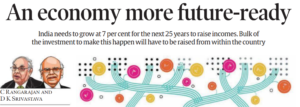- Women Reproductive autonomy as new buzzword.
- A framework to eliminate poverty in India. (Indian Express)
- The school of my dreams. (Indian Express)
- AI must be harnessed to build smart villages (The Statesman)
Topic 1: Women Reproductive autonomy as new buzzword
Introduction:
- As we commemorate World Population Day, it is crucial to highlight India’s progress in family planning initiatives and its achievements in areas like maternal health, life expectancy, and gender empowerment.
- However, amidst these successes, it is essential to shift the focus towards ensuring reproductive autonomy for each woman.
Understanding Reproductive Autonomy:
- Reproductive autonomy is the fundamental right of individuals to make informed decisions about their reproductive health and choices without interference, coercion, or discrimination.
- It encompasses the freedom to decide whether or when to have children, the number of children to have, and the spacing between pregnancies.
- Access to comprehensive reproductive healthcare services, including family planning methods, contraceptives, sexual education, prenatal care, safe abortion services, and support for reproductive health decisions, is vital in achieving reproductive autonomy.
India’s Progress in Family Planning:
- India has been lauded for its family planning initiatives, aiming to provide comprehensive reproductive health services to all potential beneficiaries.
- These efforts have expanded the contraceptive basket, offering a range of modern contraceptives and information to individuals.
- Notably, maternal health has improved significantly, reflected in the reduced maternal mortality rate.
- Moreover, India has made strides in empowering women and girls, with reductions in child marriages and teen pregnancies, as well as improved access to vital services and increased life expectancy.
Challenges Faced by Women in India:
- Despite the progress, many women in India still lack physical autonomy and decision-making power.
- The National Family Health Survey indicates that only a small percentage of women can independently make decisions about their own health.
- Additionally, societal acceptance of marital violence under certain circumstances remains a concerning issue.
- Unplanned pregnancies are also prevalent, highlighting the need for effective family planning services and education.
- Persistent gender disparities and societal attitudes that perpetuate discrimination and violence continue to hinder women’s empowerment.
Opportunities for India:
- India has a significant opportunity to advance gender equality, which can have far-reaching positive effects on economic growth, social progress, and inclusive development.
- By increasing women’s labor force participation, India could unlock substantial economic growth potential.
- Empowering women through education and family planning can lead to the accumulation of human capital, essential for sustainable development and economic progress.
- Harnessing women’s potential across various sectors can tap into their talent, ideas, and innovation.
The Way Forward:
- To realize these opportunities, investments in women’s lives are crucial, from childhood to adulthood.
- This includes access to quality education, healthcare, and support systems that enable women to make informed choices and assert their rights.
- Formulating and implementing rights-based legislation and policies that empower women and marginalized individuals are essential steps.
- Providing accessible, affordable, and high-quality comprehensive reproductive health services should remain a priority.
Furthermore, adopting gender-just approaches and challenging societal norms that perpetuate discrimination and violence are fundamental in building a prosperous and inclusive India.
Topic 2: A framework to eliminate poverty in India.

Introduction:
- With the receding impact of Covid-19 and hopeful prospects for an amicable resolution to the Russia-Ukraine War, India now faces the crucial task of charting its future growth strategy.
- The current per capita income of $2,379 in 2022-23 needs to be raised significantly over the next 25 years to pave the way for a higher standard of living and eradicate poverty.
- Achieving this ambitious goal requires a comprehensive understanding of the challenges ahead and the necessary actions to overcome them.
Understanding Per Capita Income:
- Per capita income represents the average income earned by individuals in a specific geographic area.
- It is calculated by dividing the total income of a population by the total number of individuals in that population.
- This figure provides insights into the average standard of living and economic well-being within the country.
Gross Fixed Capital Formation (GFCF):
- GFCF refers to the total value of investment in fixed assets within an economy, including machinery, equipment, buildings, and infrastructure, during a specific period.
- It is a crucial driver of economic growth as higher levels of investment contribute to increased production capacity, improved productivity, and long-term development.
Incremental Capital-Output Ratio (ICOR):
- ICOR is an economic indicator that measures the amount of investment required to generate an additional unit of output or GDP.
- A lower ICOR indicates higher efficiency and productivity of capital, while a higher ICOR suggests lower efficiency of capital utilization.
Growth Target and Investment Requirements:
- To sustain continuous growth of 7 percent over the next 25 years, India must maintain a GFCF rate of 28 percent.
- However, recent trends indicate an average ICOR of 4.65 from 2016-17 to 2022-23, necessitating an estimated investment rate of 30-32 percent of GDP.
- Both public and private investments, including foreign direct investment in emerging technological sectors, need to increase to promote growth and generate employment opportunities.
Global Challenges:
- Several global factors pose challenges to India’s growth strategy. Prolonged conflicts like the Ukraine-Russia conflict can negatively impact global stability and economic growth.
- Additionally, the shifting attitude of some countries towards global trade and restrictions on imports may affect India’s competitiveness in the world market.
- Supply disruptions of critical imports, such as oil, can also create setbacks for the Indian economy.
- Furthermore, the absorption of new technologies like Artificial Intelligence (AI) may impact the industrial structure and employment landscape, necessitating adjustments in the growth rate.
Strategies for Sustained Growth:
- India must adopt a multi-dimensional approach to sustain its growth.
- This involves focusing on agriculture, manufacturing, and exports, while preserving and enhancing its strength in the services sector.
- Preparing to absorb new technologies, reorienting the educational system to equip students with required skills, and identifying labor-intensive economic activities are essential steps to address potential job losses due to technological advancements.
Conclusion:
India’s journey towards sustained growth requires addressing domestic challenges, embracing opportunities, and prioritizing inclusive development.
By pursuing these strategies and maintaining a market-oriented approach, India can realize its vision of a prosperous and equitable future.
Topic 3: India@75, Looking at 100: The school of my dreams
Note: Read this article as it is, as it is good for essay. A must-read article.
Introduction:
- The article is set in the year 2047, during a school celebration where past and present members of the school community gather to commemorate the transformation of the education system.
- The school compound is bustling with children, families, and friends, both physically present and virtually linked through technology.
- The school, though unchanged from the outside, has undergone significant internal transformation, embracing new pedagogical approaches and fostering a culture of exploration and innovation.
The Path to Progress
- 25 years ago, a devastating pandemic forced the closure of schools for two years. When they reopened, educators and anganwadi instructors realized the importance of building strong foundations for early learning.
- Mothers and families actively engaged in supporting their children’s learning, both at home and in the community, laying the groundwork for a seamless transition from anganwadi to primary school.
Empowering Middle School Students
- Middle school students are now excitedly presenting a film they made about a pressing local issue – water scarcity.
- The school encourages students to work collaboratively and use real-life situations for learning, moving beyond traditional textbooks.
- Through their efforts, students are developing water storage solutions in partnership with adults, demonstrating how education can be a catalyst for community improvement.
Breaking the Exam-Centric Culture
- High school students now enjoy a more flexible and individualized approach to assessments. Exams are no longer high-stakes; students can take them online whenever they feel ready.
- The school encourages entrepreneurship and offers seed funding for student-led projects, fostering creativity and initiative.
Conclusion:
The article emphasizing the importance of transformative education, where each child can explore their interests and potential.
Schools, families, and communities must work together systematically and persistently to build strong foundations, provide diverse learning pathways, and offer ample opportunities for growth.
By leveraging the past, building the present, and planning for a better future, the school can serve as the anchor of community life and drive progress in education. The vision is for all schools to celebrate such achievements by August 15, 2047.
Topic 4: AI must be harnessed to build smart villages
Introduction
- The article emphasizes the importance of leveraging AI and technology to empower rural communities in the face of climate change and social inequities.
- It argues that instead of solely focusing on smart cities, attention should be given to developing smart omni-villages that can contribute to climate action and bridge the gap between rural and urban areas.
- The article highlights three key points: the need for bottom-up approaches, the role of AI as a curator of knowledge, and the potential of a Global Creative Commons (GCC) tech platform.
- Bottom-up Approach:
- Traditional top-down governance structures lack coordination and feedback, hindering effective solutions to human problems.
- Inclusive sustainable development requires a mindset change towards local action and community-driven initiatives.
- Villages, as stewards of land and seas, play a vital role in providing essential resources to cities while safeguarding nature.
- AI as a Curator of Knowledge:
- The availability of data and AI can create a systemic data dashboard for Earth, enhancing decision-making at all levels.
- AI can connect siloed datasets, fill data gaps, and foster transparency and trust in the data ecosystem.
- A tech platform or Global Creative Commons (GCC) can curate and disseminate customized knowledge to social enterprises and micro-small medium enterprises (MSMEs) through AI.
- GCC and Smart Omni-Villages:
- A multidimensional development model is needed to co-create well-being and well-becoming in a diverse, multi-polar world.
- Smart omni-villages, empowered by AI, can exchange knowledge, know-how, and funding through village-level data dashboards.
- The GCC becomes a tech platform that matches global know-how with local problems, facilitating circular economic behavior and conserving nature.
- AI can unlock the untapped potential of rural communities, allowing them to monetize their knowledge and contribute to advancements in various fields.
- By incentivizing AI developers to build next-generation GCCs, smart omni-villages can be networked and empowered to tackle complex challenges.
- The ultimate goal is to utilize AI for social and ecological justice, bridging the gap between rural and urban areas and creating positive outcomes globally.
Conclusion
The article highlights the transformative potential of AI in empowering rural communities and driving sustainable development.
By adopting a bottom-up approach, leveraging AI as a curator of knowledge, and establishing a GCC tech platform, smart omni-villages can contribute to climate action, bridge social gaps, and create a more equitable and sustainable future.


